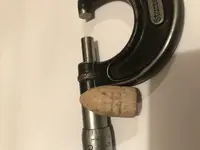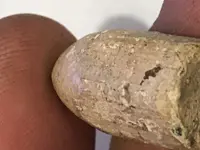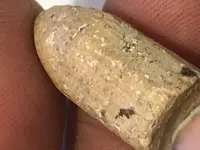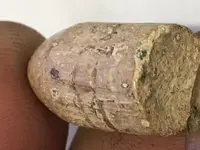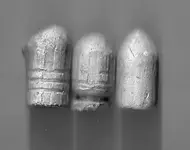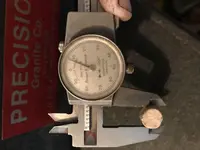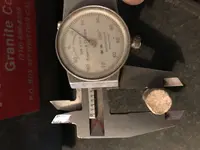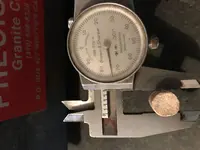You are using an out of date browser. It may not display this or other websites correctly.
You should upgrade or use an alternative browser.
You should upgrade or use an alternative browser.
Hex bullet ID ?
- Thread starter Blkcloud
- Start date
Tpmetal
Silver Member
- Joined
- Jan 4, 2017
- Messages
- 4,593
- Reaction score
- 7,932
- Golden Thread
- 0
- Location
- Western ny
- Detector(s) used
- equinox 800, Whites mx sport, Garrot carrot, bounty hunter time ranger
- Primary Interest:
- All Treasure Hunting
Whitworth?? but it doesnt look like that bullet, maybe it was carved? can we get better pics of different angles?
Upvote
0
P.ALLEN
Hero Member
- Joined
- Jun 8, 2017
- Messages
- 642
- Reaction score
- 811
- Golden Thread
- 0
- Location
- A2 Michigan
- Detector(s) used
- AT Pro, Tesoro Compadre, Ace 250, CMS magnetics, Garrett pinpointer, Fiskars trenching spade.
- Primary Interest:
- All Treasure Hunting
maybe a sharps?
Upvote
0
Charlie P. (NY)
Gold Member
- Joined
- Feb 3, 2006
- Messages
- 13,021
- Reaction score
- 17,188
- Golden Thread
- 0
- Detector(s) used
- Minelab Musketeer Advantage Pro w/8" & 10" DD coils/Fisher F75se(Upgraded to LTD2) w/11" DD, 6.5" concentric & 9.5" NEL Sharpshooter DD coils/Sunray FX-1 Probe & F-Point/Black Widows/Rattler headphone
- Primary Interest:
- Metal Detecting
Looks like a bullet fired from a six-groove (like an Enfield? Boucher?) to me
Upvote
0
DownNDirty
Bronze Member
- Joined
- Jun 1, 2015
- Messages
- 2,178
- Reaction score
- 3,207
- Golden Thread
- 1
- Location
- South Carolina
- 🥇 Banner finds
- 1
- 🏆 Honorable Mentions:
- 1
- Detector(s) used
- Minelab Equinox 800
- Primary Interest:
- All Treasure Hunting
As posted above this is a fired bullet; it was round before it was fired, not hexagonal.
Upvote
0
- Joined
- Mar 5, 2010
- Messages
- 7,664
- Reaction score
- 12,439
- Golden Thread
- 0
- Location
- Southwest Georgia
- Detector(s) used
- XP Deus, White's DFX
- Primary Interest:
- All Treasure Hunting
Please post a picture of the base and the nose looking up and down the bullet if you can. It does look like it has flat sides on it. Do they run straight or at a diagonal? I thought maybe a round bullet fired through a Whitworth rifle if that would be possible.
Last edited:
Upvote
0
GeoW
Hero Member
- Joined
- Jul 12, 2005
- Messages
- 527
- Reaction score
- 568
- Golden Thread
- 0
- Location
- Coastal Georgia
- Detector(s) used
- XP Deus II, XP Deus, XP ORX, Nautilus DMCllBa, Troy X5 Shadow, Tesoro Vaquero, Tesoro Outlaw
Please post a picture of the base and the nose looking up and down the bullet if you can. It does look like it has flat sides on it. Do they run straight or at a diagonal? I thought maybe a round bullet fired through a Whitworth rifle if that would be possible.
Looks too short and too fat to be a Whitworth. Looks like rifling engraved by firing the gun to me.
g
Upvote
0
TheCannonballGuy
Gold Member
- Joined
- Feb 24, 2006
- Messages
- 6,606
- Reaction score
- 13,450
- Golden Thread
- 0
- Location
- Occupied CSA (Richmond VA)
- Detector(s) used
- White's 6000, Nautilus DMC-1, Minelab
- Primary Interest:
- Relic Hunting
For over 40 years, I've been digging and collecting and very closely studying what I call "interesting" FIRED civil war bullets. I particularly like ones which were fired but show almost no damage and have really excellent rifling-marks on them. That's the case with Blckcld's mystery bulet. Only one thing keeps me from being sure his bullet is a Spencer (or a Merrill) slug force-loaded into the oversized breech of a .52 Sharps Carbine and fired through it, which squeezes the .552"-diameter lead bullet down to fit through the 6-rifling-grooves .52" Sharps bore. The result would be a somewhat "stretched" bullet showing six superb rifling-grooves, giving the bullet a Hexagonal appearnace. Also, the bullet's base comes out looking a bit cupped... as we see on Blckcld's bullet.
The photo below shows three .57"-diameter bullets which were fired out of a .52-caliber Sharps Carbine. You can see that each is somewhat stretched, and shows superb 6-groove rifling marks.
The reason I believe Blckcld's bullet is a Spencer slug (the lead from a Spencer cartridge) is that the lowest of its three body-grooves is indistinct... which is what you see in the photo of an unfired Spencer slug in the Thomas-&-Thomas book on civil war bullets & cartridges, bullet #87.
The "only one thing which keeps me from being sure" is, his bullet's diameter measurements are too small to have been fired from a .52-caliber rifle/carbine. It wouldn't come out of the barrel measuring .475 - .508 - .512-inch. Only a .48"-caliber bore (with deep rifling-grooves) could produce those measurements. The only civil war era .48-caliber firearm listed in the McKee-&-Mason book on civil war projectiles is a Smith Rifle... which had 3-groove rifling, so that cannot be the answer about Blckcld's bullet.
No offense intended, but the only answer I can think of is that he mis-measured the bullet. I'd like to see the result of re-measuring it, this time with a digital caliper's blade-like jaws.
The photo below shows three .57"-diameter bullets which were fired out of a .52-caliber Sharps Carbine. You can see that each is somewhat stretched, and shows superb 6-groove rifling marks.
The reason I believe Blckcld's bullet is a Spencer slug (the lead from a Spencer cartridge) is that the lowest of its three body-grooves is indistinct... which is what you see in the photo of an unfired Spencer slug in the Thomas-&-Thomas book on civil war bullets & cartridges, bullet #87.
The "only one thing which keeps me from being sure" is, his bullet's diameter measurements are too small to have been fired from a .52-caliber rifle/carbine. It wouldn't come out of the barrel measuring .475 - .508 - .512-inch. Only a .48"-caliber bore (with deep rifling-grooves) could produce those measurements. The only civil war era .48-caliber firearm listed in the McKee-&-Mason book on civil war projectiles is a Smith Rifle... which had 3-groove rifling, so that cannot be the answer about Blckcld's bullet.
No offense intended, but the only answer I can think of is that he mis-measured the bullet. I'd like to see the result of re-measuring it, this time with a digital caliper's blade-like jaws.
Attachments
Upvote
0
Blkcloud
Jr. Member
- Joined
- Apr 9, 2016
- Messages
- 84
- Reaction score
- 86
- Golden Thread
- 0
- Primary Interest:
- All Treasure Hunting
- #11
Thread Owner
Don't have any digitals.. but these will do..For over 40 years, I've been digging and collecting and very closely studying what I call "interesting" FIRED civil war bullets. I particularly like ones which were fired but show almost no damage and have really excellent rifling-marks on them. That's the case with Blckcld's mystery bulet. Only one thing keeps me from being sure his bullet is a Spencer (or a Merrill) slug force-loaded into the oversized breech of a .52 Sharps Carbine and fired through it, which squeezes the .552"-diameter lead bullet down to fit through the 6-rifling-grooves .52" Sharps bore. The result would be a somewhat "stretched" bullet showing six superb rifling-grooves, giving the bullet a Hexagonal appearnace. Also, the bullet's base comes out looking a bit cupped... as we see on Blckcld's bullet.
The photo below shows three .57"-diameter bullets which were fired out of a .52-caliber Sharps Carbine. You can see that each is somewhat stretched, and shows superb 6-groove rifling marks.
The reason I believe Blckcld's bullet is a Spencer slug (the lead from a Spencer cartridge) is that the lowest of its three body-grooves is indistinct... which is what you see in the photo of an unfired Spencer slug in the Thomas-&-Thomas book on civil war bullets & cartridges, bullet #87.
The "only one thing which keeps me from being sure" is, his bullet's diameter measurements are too small to have been fired from a .52-caliber rifle/carbine. It wouldn't come out of the barrel measuring .475 - .508 - .512-inch. Only a .48"-caliber bore (with deep rifling-grooves) could produce those measurements. The only civil war era .48-caliber firearm listed in the McKee-&-Mason book on civil war projectiles is a Smith Rifle... which had 3-groove rifling, so that cannot be the answer about Blckcld's bullet.
No offense intended, but the only answer I can think of is that he mis-measured the bullet. I'd like to see the result of re-measuring it, this time with a digital caliper's blade-like jaws.
Upvote
0
TheCannonballGuy
Gold Member
- Joined
- Feb 24, 2006
- Messages
- 6,606
- Reaction score
- 13,450
- Golden Thread
- 0
- Location
- Occupied CSA (Richmond VA)
- Detector(s) used
- White's 6000, Nautilus DMC-1, Minelab
- Primary Interest:
- Relic Hunting
Yes, that type of "blade-jaws" caliper will do. Like me, you've hung onto an old 20th-Century analog version.  No batteries to quit on you at an inopportune time.
No batteries to quit on you at an inopportune time.
Actually, I was thinking of placing the blade-jaws "lengthwise" on the bullet, to measure its diameter in between the rifling-grooves. That could put us onto the caliber of the breechloading rifle which fired it.
Because the rifling-ridges can increase a bullet's diameter by .01 or .02-inch, your previous measurements suggest it could be either a .50 or .52-cailiber. We must also remember to account for the thickness of an excavated very-old bullet's lead-oxide patina, which usually is about .01-inch in total (2 x .005"), sometimes more.
I notice that in your most recent photos, the bullet shows some out-of-roundness at its base. That must be waht is causing the significant difference in your bullet's diameter measurements (.475, .508, .512-inch).
 No batteries to quit on you at an inopportune time.
No batteries to quit on you at an inopportune time.Actually, I was thinking of placing the blade-jaws "lengthwise" on the bullet, to measure its diameter in between the rifling-grooves. That could put us onto the caliber of the breechloading rifle which fired it.
Because the rifling-ridges can increase a bullet's diameter by .01 or .02-inch, your previous measurements suggest it could be either a .50 or .52-cailiber. We must also remember to account for the thickness of an excavated very-old bullet's lead-oxide patina, which usually is about .01-inch in total (2 x .005"), sometimes more.
I notice that in your most recent photos, the bullet shows some out-of-roundness at its base. That must be waht is causing the significant difference in your bullet's diameter measurements (.475, .508, .512-inch).
Upvote
0
Blkcloud
Jr. Member
- Joined
- Apr 9, 2016
- Messages
- 84
- Reaction score
- 86
- Golden Thread
- 0
- Primary Interest:
- All Treasure Hunting
- #13
Thread Owner
So.. do you think this was fired from a rifle with a hex bore? To me it definitely has six sides..nothing like any other bullet I have ever dug..Yes, that type of "blade-jaws" caliper will do. Like me, you've hung onto an old 20th-Century analog version.No batteries to quit on you at an inopportune time.
Actually, I was thinking of placing the blade-jaws "lengthwise" on the bullet, to measure its diameter in between the rifling-grooves. That could put us onto the caliber of the breechloading rifle which fired it.
Because the rifling-ridges can increase a bullet's diameter by .01 or .02-inch, your previous measurements suggest it could be either a .50 or .52-cailiber. We must also remember to account for the thickness of an excavated very-old bullet's lead-oxide patina, which usually is about .01-inch in total (2 x .005"), sometimes more.
I notice that in your most recent photos, the bullet shows some out-of-roundness at its base. That must be waht is causing the significant difference in your bullet's diameter measurements (.475, .508, .512-inch).
Upvote
0
TheCannonballGuy
Gold Member
- Joined
- Feb 24, 2006
- Messages
- 6,606
- Reaction score
- 13,450
- Golden Thread
- 0
- Location
- Occupied CSA (Richmond VA)
- Detector(s) used
- White's 6000, Nautilus DMC-1, Minelab
- Primary Interest:
- Relic Hunting
Sorry, no, not a Hexagonal bore... I agree with Charlie_P., it was fired from a rifle which had 6 rifling-grooves inside its barrel.
Upvote
0
Similar threads
- Replies
- 2
- Views
- 411
Users who are viewing this thread
Total: 1 (members: 0, guests: 1)



